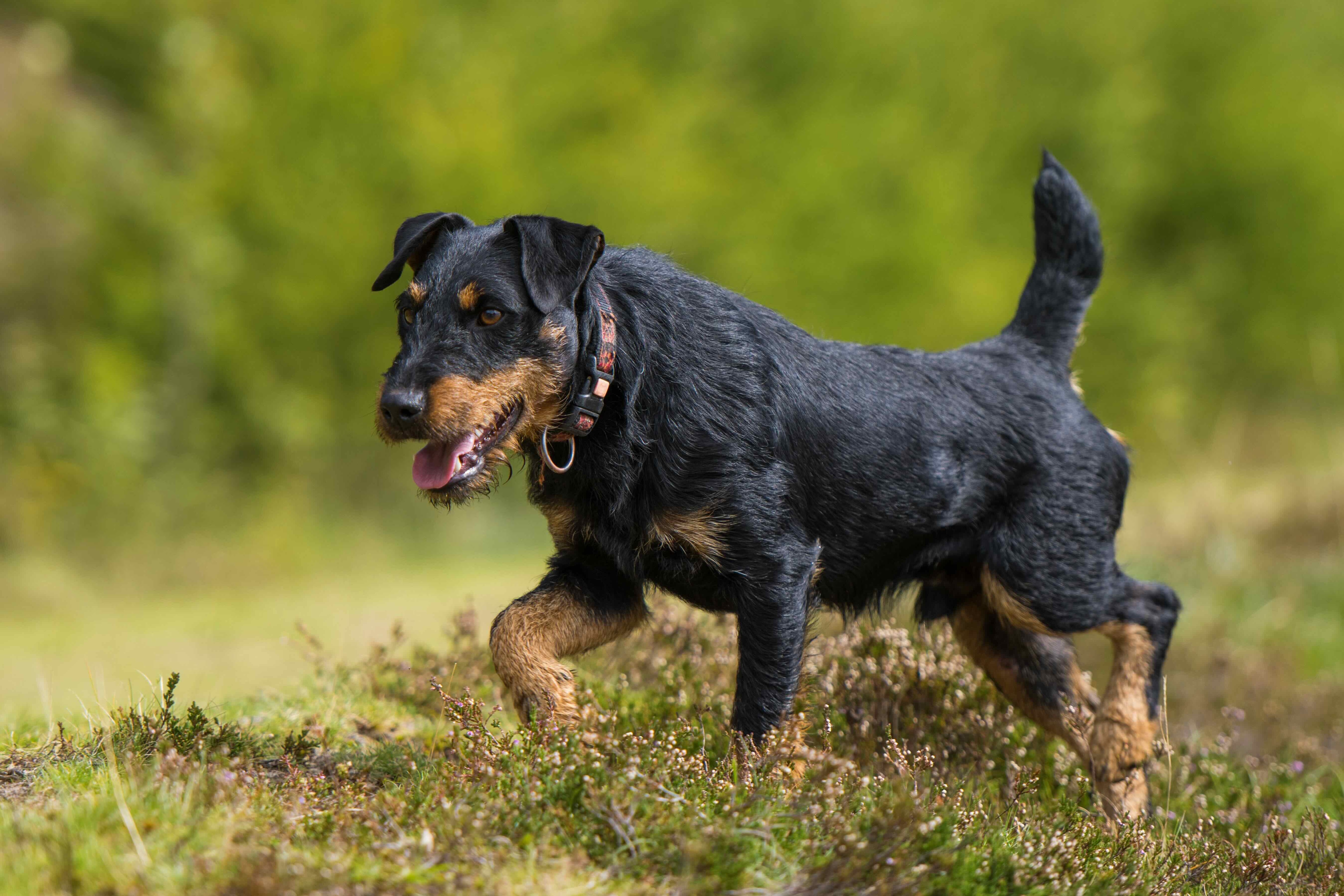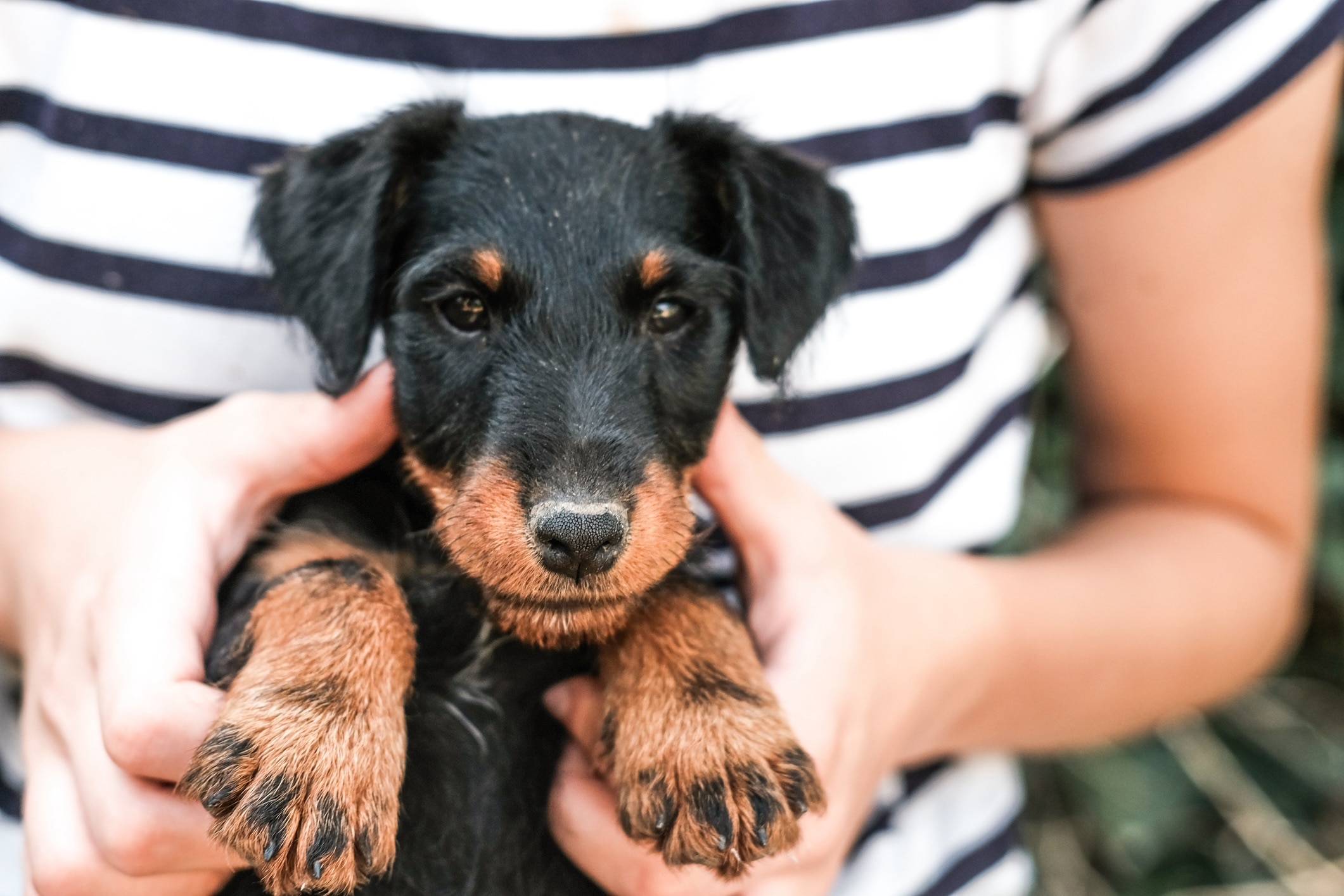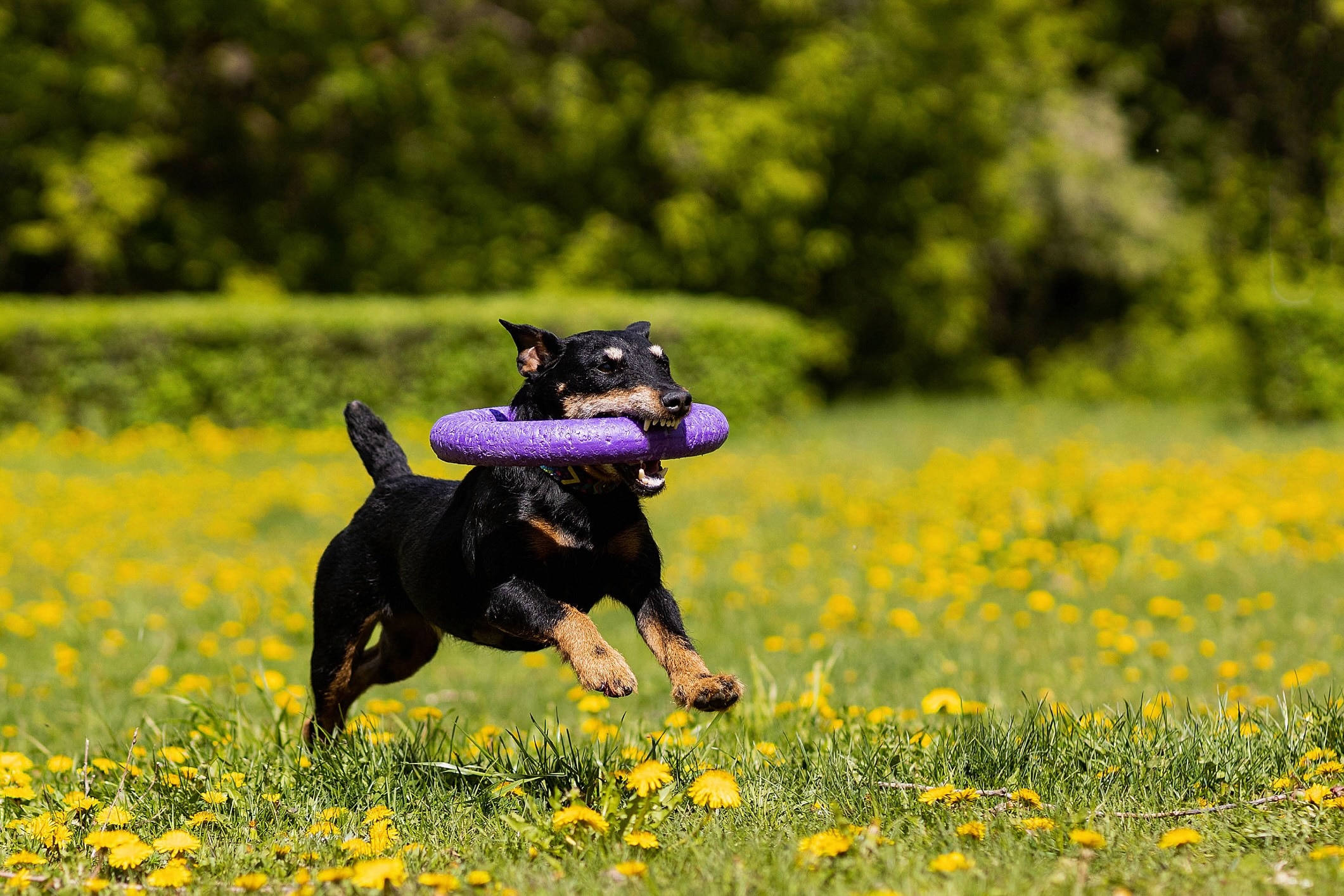Jagdterrier
Adobe Stock/otsphoto
Meet the Jagdterrier (pronounced "yack-terrier"), a small yet robust hunting dog with roots tracing back to early 20th-century Germany. According to the American Hunting Terrier Association (AHTA), Jagdterriers are incredibly versatile hunters known to track anything from mice and rabbits to cougars and bears.
Off the hunting field, Jagdterrier dogs are known for their loyalty toward their family. However, due to their high energy and strong prey drive, they require ample exercise, mental stimulation, and close supervision when outdoors.
Physically, Jagdterriers are compact and muscular, with a typical weight of 17–22 pounds and height of 13–16 inches at the shoulder. They have a dense, coarse coat that can be either black, dark brown, or black and gray, often with distinctive tan markings.
Caring for a Jagdterrier
Confident, courageous, and determined Jagdterriers have a high prey drive and are highly motivated when it comes to hunting and tracking. This breed can be loyal and affectionate with their family, but are often reserved and wary of strangers.
Early socialization is essential to ensure a Jagdterrier dog develops a well-rounded personality and remains comfortable in new situations. This breed is best suited for experienced pet parents who can handle a willful Jagdterrier personality and meet the dog’s need for structure and boundaries.
Jagdterriers also do best with active families who enjoy being outside, as their exceptionally high energy levels require significant daily exercise. Some of their favorite activities include hunting, taking long walks, running, and hiking.
Grooming-wise, Jagdterriers are relatively low-maintenance. They need regular brushing and occasional baths to keep their dense, coarse coat in good condition.
Jagdterrier Health Issues

The Jagdterrier is generally a healthy dog breed with an average lifespan of 10–12 years. However, like all dogs, they can develop certain health issues throughout their life. Pet insurance may be a good investment when bringing home a Jagdterrier puppy.
Primary Lens Luxation
Primary lens luxation (PLL) is an inherited eye disorder in Jagdterriers where the lens dislocates, leading to pain, inflammation, and potential blindness if untreated. Symptoms include eye pain, redness, cloudiness, and vision problems.
Early diagnosis through veterinary exams and genetic testing is important for treatment, which typically includes medications or, in severe cases, surgery.
James E. Mills, president of the American Hunting Terrier Association, says PLL is very common in this breed, and that Jagdterrier breeders should genetically test their dogs to avoid breeding two carriers. These tests are crucial because PLL symptoms typically don't appear until around 5 years of age.
Heart Problems
Jagdterriers can experience heart conditions, including arrhythmias (irregular heartbeat) and heart murmurs. Symptoms may include lethargy, coughing, breathing difficulties, and fainting.
Keeping up with regular veterinary exams can help detect these and other health problems early and lead to more effective treatment. It’s also important to work with a responsible breeder who screens their dogs for heart problems.
Hip Dysplasia
Hip dysplasia in dogs is a genetic condition where the hip joint doesn't fit properly, leading to mobility issues. This misalignment can cause discomfort, pain, and eventually arthritis as the dog ages.
Symptoms may include limping, difficulty rising or jumping, and a reluctance to go up or down stairs. While not all dogs with hip dysplasia show symptoms, regular veterinary checkups and maintaining a healthy weight can help prevent the condition.
Treatment often consists of joint supplements, pain medication, and surgery if the case is severe.
Allergies
Allergies in dogs can have different causes, including environmental allergens (such as pollen or dust mites), food ingredients, or flea bites. They can manifest as:
-
Itchy skin
-
Redness
-
Recurring ear infections and skin infections
Identifying and avoiding the allergen, along with veterinary-recommended treatments such as antihistamines, monthly flea and tick preventatives, or specialized diets, can help manage symptoms. Talk to your vet if you suspect your Jagdterrier has allergies.
Hypothyroidism
Hypothyroidism is a condition in which the thyroid gland doesn't produce enough hormones. Symptoms can include weight gain, lethargy, hair loss, and skin problems.
This condition is typically diagnosed through blood tests and can be managed with daily hormone replacement medication prescribed by a veterinarian. Affected dogs typically live long and healthy lives with proper medical management.
What To Feed a Jagdterrier

Choosing the right dog food for a Jagdterrier involves considering their high energy levels, nutritional needs, and potential health concerns.
Opt for high-quality protein sources, balanced nutrients, and calorie-dense options to support their active lifestyle. It can be a good idea to include joint-supporting ingredients such as glucosamine and chondroitin, and to consider antioxidants for eye health. Any food you give your dog should meet the nutritional standards set by the Association of American Feed Control Officials (AAFCO).
Always consult your veterinarian for personalized dietary advice to ensure your Jagdterrier remains healthy and thriving.
How To Feed a Jagdterrier
Establishing a feeding routine for your Jagdterrier involves tailoring it to their age and activity level. Generally, adults thrive on two meals a day to maintain consistent energy levels and prevent overeating, while Jagdterrier puppies may need three to four smaller meals to support growth and prevent hypoglycemia (low blood sugar).
Always talk with your veterinarian for personalized advice to ensure your Jagdterrier receives the best nutrition. It’s also important to choose high-quality dog food compliant with AAFCO guidelines and formulated for your dog’s life stage (puppy, adult, or senior).
How Much Should You Feed a Jagdterrier?
How much your dog should eat depends on their age, weight, activity level, and health.
Your preferred dog food should have a feeding guide on the packaging that details portion sizes. Use this as a starting point, and talk to your vet for further guidance. A vet can give you more detailed feeding advice for your specific dog.
Nutritional Tips for Jagdterriers
Your veterinarian may prescribe a dog supplement for your pup, depending on their health needs. Never give your dog a supplement without speaking with your vet first.
Behavior and Training Tips for Jagdterriers
Jagdterrier Personality and Temperament

Jagdterriers are known for their high energy, intelligence, and strong work ethic. Pet parents can expect a highly active and driven dog that thrives with a job to focus on.
While they can be affectionate with their families, Jagdterriers are often more reserved around strangers, making early socialization essential. Well-socialized Jagdterriers can be good with children and around other pets with proper introductions, but their hunting history and strong prey drive might make them a questionable choice for homes with small animals.
Jagdterriers fit best with active pet parents who can provide the necessary exercise and training to keep them happy and well-behaved.
Jagdterrier Behavior
Jagdterriers love exploring their environment due to their highly curious nature. They tend to bark frequently, especially if they’re bored or sense something unusual. As a terrier breed, Jagdterriers also have a natural instinct to dig and chase whatever catches their eye. Keeping your dog mentally stimulated and exercised can help prevent unwanted behaviors.
While these dogs are not typically anxious or fearful, inadequate socialization—or a lack of mental and physical stimulation—can lead to such issues. Mills says it’s important to focus the Jagdterrier’s drive into positive activities, such as dock diving or tracking game.
If you take your Jagdterrier hunting, make sure to keep your dog safe. Jagdterriers also excel in dog sports such as obedience, agility, and tracking. They require at least an hour of vigorous exercise every day.
Jagdterrier Training
Jagdterriers, like every dog, do best with training based on positive reinforcement. Use treats, toys, and praise when your dog follows your cues, but be mindful not to overfeed your Jagdterrier treats.
Early socialization, mental stimulation, and regular exercise are crucial to prevent anxiety and destructive behaviors. In particular, it’s important to teach your dog recall due to their high prey drive. Always keep your Jagdterrier within a fenced yard or on a leash when outside to prevent them from running after smaller animals.
Fun Activities for Jagdterriers
Jagdterrier Grooming Guide
Jagdterriers have a dense, hard coat that provides good protection when hunting in the field. They have a moderate shedding level, which increases slightly during seasonal changes (spring and fall).
Skin Care
Jagdterriers typically do not require special skin care. However, as with any breed, it's essential to monitor for signs of irritation, dryness, or changes in their skin. Talk to your vet if anything questionable arises.
Coat Care
Brush your Jagdterrier’s coat about once a week to prevent matting and remove loose hair. While professional grooming isn’t typically needed, occasional trimming around sensitive areas, like the ears and paws, helps maintain cleanliness.
Eye Care
Generally, Jagdterriers do not require special care. Regular veterinary checkups ensure any eye issues are caught early.
Ear Care
Regularly checking and cleaning your dog’s ears can help prevent wax buildup and reduces the risk of infections. Ask your veterinarian for the best dog-friendly ear cleaner to use.
Monitor your Jagdterrier for signs of irritation, redness, or an unusual odor—these are all signs of an ear infection in dogs. Talk to your vet if you notice changes in your dog’s ears.
Considerations for Pet Parents
Before bringing home a Jagdterrier puppy, prospective pet parents should consider what this dog breed needs to thrive.
These dogs need a home where they receive ample exercise and mental stimulation. An active family who enjoys outdoor activities such as hiking or jogging is best, as Jagdterriers have high energy levels and require regular physical exertion.
They also need pet parents who will prioritize training and socialization, as these terriers have a strong prey drive and can take time to warm up to new people. Homes that are busy and lack time for regular exercise or training may not be suitable for this breed, as they can become bored or exhibit destructive behaviors.
Jagdterrier FAQs
Do Jagdterriers make good pets?
Yes, Jagdterriers can make excellent pets for active individuals or families who can provide regular exercise and mental stimulation.
How big does a Jagdterrier get?
Jagdterriers are typically small- to medium-sized dogs. On average, they stand 13–16 inches tall at the shoulder and weigh 17–22 pounds.
Are Jagdterriers rare?
Yes, Jagdterriers are a rare dog breed in the U.S.
How much does a Jagdterrier cost?
The cost of a Jagdterrier can vary widely depending on factors such as breeder reputation, pedigree, location, and whether the dog is intended for hunting or as a pet. According to Mills, Jagdterrier prices can range from $500 to $1,500.
